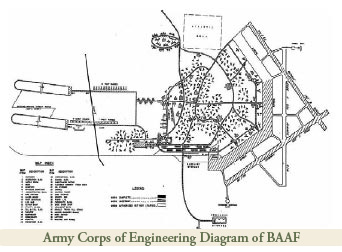History of the Buckingham Airfield
Buckingham Army Airfield was a flexible gunnery training base, used to train gunners who would defend bombers. It was constructed in 1942 at a cost of 10 million dollars. It encompassed a total of 7,000 acres and had a series of canals constructed on it to drain the swamp land. During its peak the base had 6 runways, housed over 16,000 men and women, contained approximately 700 buildings and graduated over 48,000 aerial gunners. Buckingham Army Airfield was the first school for flexible gunnery instructors. The base was closed on September 30, 1945.
For a brief time the barracks of Buckingham Air Field were used as the classrooms for Edison College. Edison moved out in 1948. In 1968, the Lee County Mosquito Control District (LCMCD) moved its’ operations from Canal Street in Fort Myers to the Buckingham Army Air Field in Lehigh Acres. The six runways were gone along with almost all of the buildings. The site had shrunk to approximately 250 acres. There remains one, original building from the base on the property. The airport is often referred to on aeronautical maps as Lehigh West Airport. It is operated as a private field and called FL59 – Buckingham Field Airport by LCMCD.
On July 5, 2002 the Fort Myers Historical Museum; Experimental Aircraft Association, Florida Warbirds, Squadron 24; Lee County Board of Commissioners; Leadership Lee County and LCMCD celebrated the 60th Anniversary of the Buckingham Army Air Field. The Anniversary was celebrated to set aside time to remember those civilian and military personnel who worked, served and trained at the base. A historical marker commemorating the former Buckingham Army Air Field was erected at the intersection of Gunnery Boulevard and Sunset Road.
 Dawn Seymour, World War II WASP, Tours Buckingham Airfield
Dawn Seymour, World War II WASP, Tours Buckingham Airfield
On March 15, 2014, Dawn Seymour, a WWII B-17 Pilot, visited the Buckingham Airfield for the first time in 70 years. As a member of the Women Airforce Service Pilots, better known as WASP, she was one of only 13 women who completed the challenging B-17 flight training program- the same program designed for the male pilots who trained for combat missions. Kirby Bradford, Tactical Flight Officer from the Lee County Sheriff’s Aviation Unit, displayed dozens of items of memorabilia for the visit. Such items included including pictures, postcards, newspapers, and books, but he also displayed navigational charts and a target used for aerial gunnery.
Lunch was provided by the Lee County Sheriff’s Office at their hangar before touring other parts of the Buckingham Airfield, including Lee County Mosquito Control. As Seymour toured, she recalled experiences with thoughtfulness and clarity. When she was told that the beacon used during WWII still operated atop a maintenance hangar she smiled and commented, “That beacon was always a friend,” and then added, “And lighted oil drums lined the runways for us at night.”
Seymour faced many challenges during her days at the Buckingham Airfield. Flying the B-17 meant dealing with various mechanical issues. “It was the number three engine that always seemed to give us trouble,” and then added, “But it wasn’t a big problem to lose the number three engine- not like losing the number one or four.” Additional details about the era were also relayed. “There were three means of communicating long-distance,” she explained. “Telegraph, letters posted with a 5 cent stamp and by telephone- as long as you made an appointment for one.” Newspapers cost 25 cents and Seymour earned $250 per month.
During her visit, Seymour never lost enthusiasm or energy. When asked about her secret for long-term physical and mental health she considered then answered, “Being around young people; they charge me.” Then she quickly added, “And of course the loving support of my family.”
